Such a rapidly changing digital landscape, the need for secure, transparent and efficient transaction systems has grown to an extraordinary level. Transaction methods through blockchain have emerged as a revolutionary solution, one that significantly alters how people and businesses exchange value in the online world.
At its core, blockchain technology is a form of distributed ledger that records transactions simultaneously at multiple computers. It thus creates a permanent record that cannot be altered without network consensus, hence establishing trust without intermediaries.
The security of transactions in blockchain is due to cryptographic hashing, decentralized validation, and effective consensus mechanisms which make tampering almost impossible. In addition, the openness of public ledgers allows transaction histories to be verified by anyone which is advantageous for companies as well as their clients.
Beyond cryptocurrencies, blockchain transactions have extended to several industries. Financial services use them for smart cross-border payments and automated smart contracts. Supply chains use their immutability to track products and verify authenticity. Healthcare organizations secure patient records with the assurance of authorized access. Even the real estate market is getting revolutionized through safe digital transfers of properties and transparent ownership records.
As blockchain technology develops, interoperability among networks, central bank digital currencies, decentralized finance platforms, and NFTs would be the most interesting future possibilities for blockchain transactions.
Understanding Blockchain Transactions: The Foundation of Digital Trust
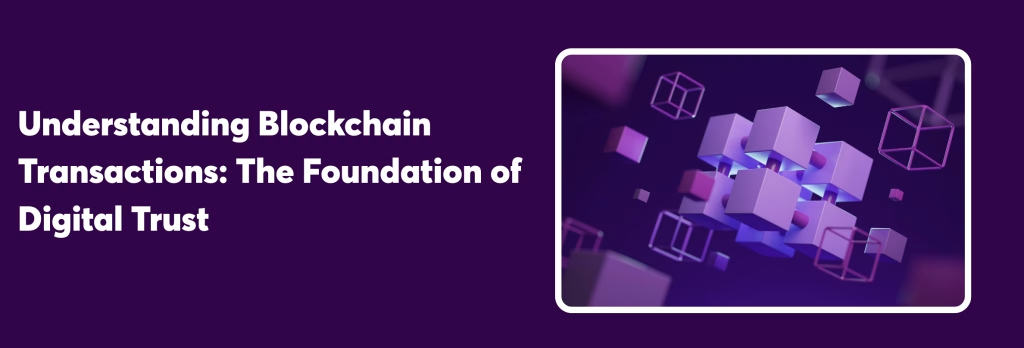
At its core, blockchain technology is a distributed ledger system that records transactions on the blockchain at the same time across many computers. Unlike a centralized database, it distributes identical copies of the ledger throughout its entire network. This creates an unchangeable record of blockchain transactions since any retroactive alteration would require changes to all subsequent blocks and network consensus.
The beauty of blockchain transaction lies in establishing trust without requiring intermediaries. When a transaction takes place in a blockchain network, it is verified by multiple network participants (nodes) before being added to the chain. This consensus mechanism verifies the legitimacy of all transactions recorded on the blockchain, thereby minimizing fraud and unauthorized tampering with transactions.
The Security Architecture That Makes Blockchain Transactions Work
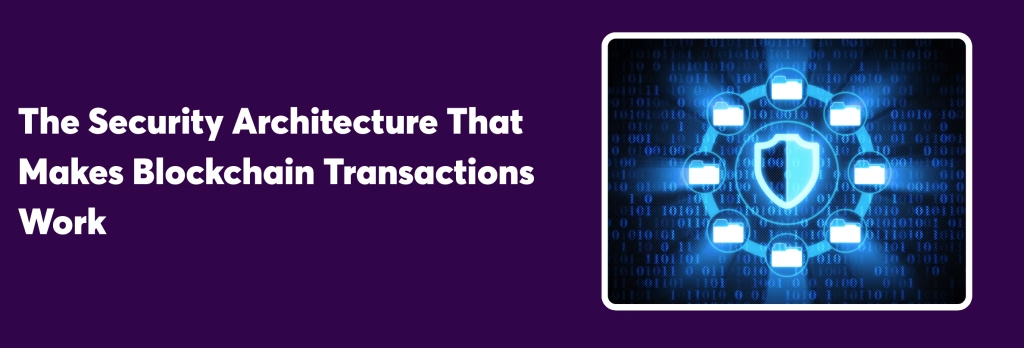
Several new architectural features work together to make blockchain transactions strong:
Hashing with Cryptography
A hash is a unique number that is stored in each block of a blockchain. This hash is made by using complicated math algorithms to turn the block’s data into a string of characters with a set length. Even the smallest change to the data would create a completely new hash, making it easy to spot changes that weren’t made by the owner.
Validation that isn’t centralized
Traditional systems for transactions depend on banks or payment processors to check them. A distributed network of computers, on the other hand, checks blockchain transactions. This decentralization gets rid of single points of failure and makes system-wide breaches much less likely.
How to Reach Agreement
Blockchain networks use different ways of reaching consensus to make sure that everyone agrees on the validity of blockchain transactions. Some common methods are:
Proof of Work (PoW): To verify transactions, people have to solve hard math problems.
Proof of Stake (PoS) means that validators are chosen based on how much cryptocurrency they own and are willing to “stake.”
Delegated Proof of Stake (DPoS): Token holders choose representatives who check transactions for them.
These systems make it very hard and not worth the money to mess with blockchain transactions.
Transparency: The Game Changer

One of the biggest benefits of blockchain is transparency. In most blockchain networks all transactions are public. This transparency builds trust and allows for independent verification of transaction history.
For businesses this means improved supply chain visibility, accountability and faster auditing. You can track goods and services with clarity, reduce disputes and streamline operations.
For consumers this means more confidence in product authenticity and ethical sourcing. When a product’s journey from manufacturer to consumer is recorded on a blockchain you can verify its origin and handling, stop counterfeits and unethical practices.
Alternative to Cryptocurrency: Block-Chain and Transaction Beyond the World of Crypto

The original context of blockchain technology was in cryptocurrencies (BTC, ETH, etc.) Blockchain transactions have now moved way beyond digital currencies.
They are the bread and butter of multiple industries, which in turn shift all aspects of global economy from cookie-cutter to bespoke.
Financial Services
Blockchain transactions are being embraced in the financial sector as a way to make cross-border payments faster and more affordable, decreasing settlement times and costs. Now days, traditional international transfer that can take days to be processed can be done within minutes using blockchain transactions this imprinted traceability and low fees.
Smart contract — automation of the previously complex process (eg: insurance claims; loan approval, etc.) with code written but still valid to be done by these programmable blockchain transactions are automatically carried out when configured conditions are met thus eliminating admin overhead and minimizing disputes.
Supply Chain Management
The immutability and transparency that blockchain transactions offer make it highly advantageous to supply chain. One way companies can start the use of blockchain for recording goods transfer on it is by
Track Products From Origin to Consumer
Verifiable Authenticity Meaning Counterfeit Protection
Comply with the regulations
Onc the inefficiencies and bottlenecks are identified in real time
This example is Walmart has used blockchain to track food products along its supply chain, meaning that the giant retailer can source where an individual item of products came from in seconds NOT days.
Healthcare
Blockchain transactions in healthcare are a game changer for medical record keeping. Secure data stored on blockchain networks, open by permissioned nodes but immune to any unauthorized altercations; patient info can only be seen by authorized parties.
Which better coordination among providers, decreased medical mistakes, and enabled the patient with a higher level of information about their health records.
Blockchain transactions are also making clinical trials more transparent. Researchers can keep track of data integrity and compliance with regulations by immutably recording their trial data on ledgers that will never be changed a results, more of which should be open to the scientific community.
Real Estate
Most land transactions are transacted with the help of intermediaries and are lengthy, archaic processes. Blockchain transactions similarly streamline the process of digital property transfers secured via escrow through smart contracts (trustless autobidding), transparent ownership records and a escrow.
Currently, blockchain-based land registry systems in countries like Georgia and Sweden are drastically reducing the amount of fraud as well as administrative costs from property transactions.
Overcoming Challenges in Blockchain Transaction Adoption
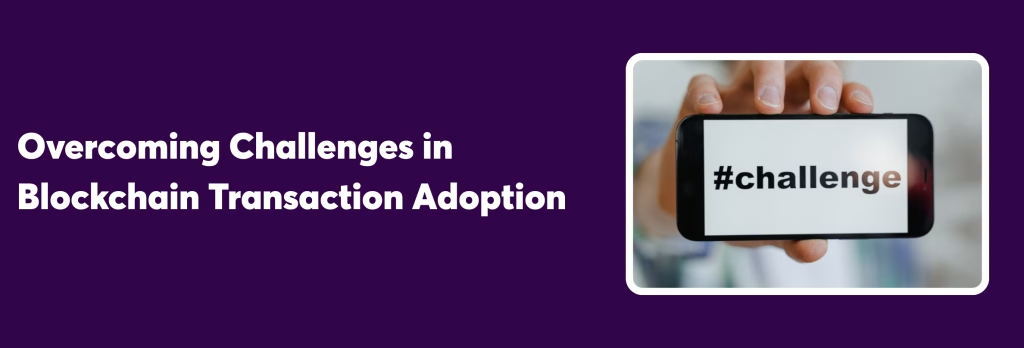
Despite their transformative potential, widespread adoption of blockchain transactions faces several challenges:
Scalability Issues
Many blockchain networks struggle with transaction throughput limitations. While traditional payment processors like Visa can handle thousands of transactions per second, some blockchain networks process fewer than 100. However, emerging solutions like layer-2 protocols and sharding promise to address these scalability concerns, making blockchain transactions more viable for high-volume applications.
Regulatory Uncertainty
The regulatory landscape for blockchain transactions remains unclear in many jurisdictions. Businesses considering implementing blockchain solutions must navigate evolving legal frameworks, which can vary significantly across regions. This regulatory uncertainty sometimes delays adoption, particularly in highly regulated industries like finance and healthcare.
Integration with Legacy Systems
For established organizations, integrating blockchain transactions with existing infrastructure presents technical challenges. Successful implementation often requires substantial investment in technology and expertise, along with careful planning to ensure compatibility with legacy systems.
Environmental Concerns
Some blockchain consensus mechanisms, particularly Proof of Work, consume significant energy resources. As sustainability becomes increasingly important for businesses and consumers alike, the environmental impact of certain blockchain transactions has come under scrutiny. In response, many newer blockchain platforms are adopting more energy-efficient consensus mechanisms.
The Future of Blockchain Transactions: Emerging Trends and Innovations
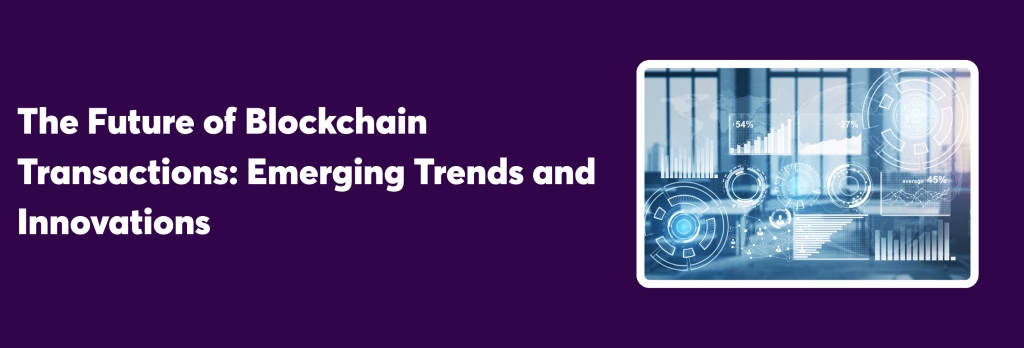
As blockchain technology matures, several exciting trends are shaping the future of blockchain transactions:
Interoperability Between Blockchains
Different blockchain networks have traditionally operated in isolation, limiting their utility. New protocols aim to enable communication between diverse blockchain ecosystems, creating a more connected and versatile transaction infrastructure. This interoperability will allow assets and data to flow freely between previously siloed networks, enhancing the potential of blockchain transactions.
Central Bank Digital Currencies (CBDCs)
Many central banks are exploring digital versions of their national currencies built on blockchain technology. These CBDCs promise to combine the efficiency and programmability of blockchain transactions with the stability and legal standing of traditional currencies. China’s digital yuan and Sweden’s e-krona are among the most advanced CBDC projects currently under development.
Decentralized Finance (DeFi)
DeFi applications leverage blockchain technology to recreate and enhance traditional financial services without intermediaries. From lending and borrowing to insurance and asset trading, DeFi platforms use blockchain transactions to provide financial services that are more accessible, efficient, and transparent than their conventional counterparts.
Non-Fungible Tokens (NFTs)
NFTs represent unique digital assets on a blockchain, enabling verifiable ownership of digital content such as art, music, and virtual real estate. By tokenizing digital assets through blockchain transactions, creators can establish scarcity and provenance in the digital realm, opening new possibilities for digital ownership and commerce.
Implementing Blockchain Transaction Solutions: Best Practices for Businesses

Organizations considering blockchain implementation should follow these guidelines to maximize the benefits of blockchain transactions:
1. Identify Specific Problem Areas
Successful blockchain adoption begins with identifying concrete business problems that blockchain transactions can address. Rather than implementing blockchain for its own sake, focus on areas where its unique properties—immutability, transparency, and decentralization—can deliver tangible improvements.
2. Start Small and Scale Gradually
Rather than overhauling entire systems at once, begin with limited pilot projects to test blockchain transactions in controlled environments. This approach allows organizations to learn from implementation challenges and refine their strategy before wider deployment.
3. Choose the Right Type of Blockchain
Different use cases require different blockchain architectures. Organizations must decide between:
- Public blockchains: Open to anyone, offering maximum transparency but less privacy for blockchain transactions
- Private blockchains: Restricted to authorized participants, providing greater control and privacy
- Consortium blockchains: Governed by a group of organizations, balancing control with collaboration
The optimal choice depends on specific business requirements, regulatory considerations, and privacy needs for your blockchain transactions.
4. Invest in Education and Expertise
Blockchain implementation requires specialized knowledge. Organizations should invest in training existing staff or partnering with blockchain experts to ensure successful deployment and maintenance of blockchain transaction solutions.
Conclusion
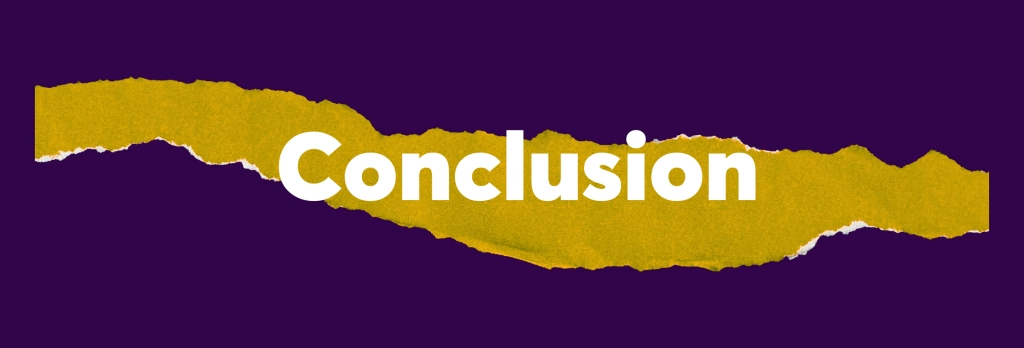
The impact of blockchain transactions extends far beyond their technological innovation. By enabling secure, transparent, and efficient exchanges of value without traditional intermediaries, blockchain transactions are fundamentally reshaping how we conduct business in the digital age.
As technical challenges are overcome and regulatory frameworks mature, we can expect to see accelerated adoption of blockchain transactions across industries. Organizations that embrace this technology thoughtfully—identifying specific use cases, starting with targeted implementations, and building the necessary expertise—will be well-positioned to reap the benefits of more secure, transparent, and efficient transaction systems.
Whether streamlining supply chains, revolutionizing financial services, or enabling new forms of digital ownership, blockchain transactions are not just a technological advancement but a paradigm shift in how we establish trust and exchange value in the digital world. As we look to the future, the promise of enhanced security and transparency through blockchain transactions will continue to drive innovation and transformation across the global economy.

